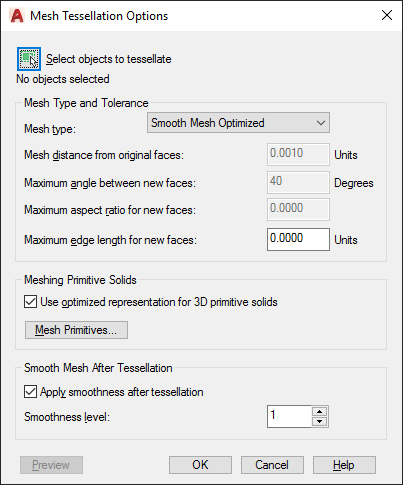Controls default settings for converting objects to mesh objects.
MESHOPTIONS (Command) Find

The defaults that you set in the Mesh Tessellation Options dialog box control the appearance of objects that you convert to 3D mesh objects. For a complete list of objects that can be converted to mesh, see the MESHSMOOTH command.
This dialog box is also available from the Options dialog box.
List of Options
The following options are displayed.
Select Objects to Tessellate
Temporarily closes the dialog box so that you can select an object to convert to a mesh object. You can select 3D solids, 3D surfaces, 3D faces, polygon or polyface meshes, regions, and closed polylines.
Mesh Type and Tolerance
Specifies the default properties of objects that are converted to 3D mesh objects. Settings that increase the number of mesh faces can slow program performance.
- Mesh Type
-
Specifies the type of mesh to be used in the conversion. (FACETERMESHTYPE system variable)
- Smooth Mesh Optimized. Sets the shape of the mesh faces to adapt to the shape of the mesh object.
- Mostly Quads. Sets the shape of the mesh faces to be mostly quadrilateral.
- Triangles. Sets the shape of the mesh faces to be mostly triangular.
- Mesh Distance from Original Faces
-
Sets the maximum deviation of the mesh faces from the surface or shape of the original object. Smaller values result in less deviation, but create more faces and might affect program performance. (FACETERDEVSURFACE system variable)
- Maximum Angle Between New Faces
-
Sets the maximum angle of the surface normal of two adjacent faces. (FACETERDEVNORMAL system variable)
Increasing this value increases the density of the mesh in areas of high curvature, and decreases the density in flatter areas. If the value of Mesh Distance from Original Faces (FACETERDEVSURFACE) is high, you can increase the maximum angle value. This setting is useful if you want to refine the appearance of small details such as holes or fillets.
- Maximum Aspect Ratio for New Faces
-
Sets the maximum aspect ratio (height/width) of new mesh faces. (FACETERGRIDRATIO system variable)
Use this value to prevent long, slivered faces. You can specify the following values:
- 0 (zero). Ignores the aspect ratio limitation.
- 1. Specifies that the height and width must be the same.
- Greater than 1. Sets the maximum ratio by which the height can exceed the width.
- Greater than 0 but less than 1. Sets the maximum ratio by which the width can exceed the height.
This option does not affect faces that are planar before conversion.
- Maximum Edge Length for New Faces
-
Sets the maximum length of any edge that is created during a conversion to a mesh object. (FACETERMAXEDGELENGTH system variable)
With the default value 0 (zero), the size of the model determines the size of the mesh faces. Setting larger values results in fewer faces and less accurate adherence to the original shape, but improves program performance. You can improve conversions that result in long, slivered faces by decreasing this value.
Meshing Primitive Solids
Specifies which settings to use when you convert 3D solid primitive objects to mesh objects.
- Use Optimized Representation for 3D Primitive Solids
-
Specifies which settings to use when you convert primitive solid objects to mesh objects. (FACETERPRIMITIVEMODE system variable)
Select the check box to use the mesh settings specified in the Mesh Primitive Options dialog box. Clear the check box to use the settings specified in the Mesh Tessellation Options dialog box.
- Mesh Primitives
-
Opens the Mesh Primitive Options dialog box.
This button is available only when Use Optimized Representation for 3D Primitive Solids is selected.
Smooth Mesh After Tessellation
Specifies what level of smoothness is applied to objects after they are converted to mesh.
When the Mesh Type option is set to Mostly Quads or Triangle, the converted mesh objects have no smoothness. The following settings are not available for those conversions.
- Apply Smoothness After Tessellation
-
Sets whether the new mesh objects are smoothed after they are converted.
Select the check box to apply smoothing.
- Smoothness Level After Tessellation
-
Sets the level of smoothness for new mesh objects. (FACETERSMOOTHLEV system variable)
Enter 0 to eliminate smoothness. Enter a positive integer for increased degrees of smoothness.
This option is available only when Apply Smoothness After Tessellation is selected.
Preview
Displays the effect of the current settings in the drawing area. Press Enter to accept the changes.
To display the dialog box again, press Esc.